
Mission San Buenaventura, formally known as the Mission Basilica of San Buenaventura, is a Catholic parish and basilica in the Archdiocese of Los Angeles. The parish church in the city of Ventura, California, United States, is a Spanish mission founded by the Order of Friars Minor. Founded on March 31, 1782, it was the ninth Spanish mission established in Alta California and the last to be established by the head of the Franciscan missions in California, Junípero Serra. Designated a California Historical Landmark, the mission is one of many locally designated landmarks in downtown Ventura.

Ventura County is a county located in the southern part of the U.S. state of California. As of the 2020 census, the population was 843,843. The largest city is Oxnard, and the county seat is the city of Ventura.

Ventura, officially named San Buenaventura, is a city in and the county seat of Ventura County, California, United States. It is a coastal city located northwest of Los Angeles. The population was 110,763 at the 2020 census. Ventura is a popular tourist destination, owing to its historic landmarks, beaches, and resorts.

The California Republic, or Bear Flag Republic, was an unrecognized breakaway state from Mexico, that for 25 days in 1846 militarily controlled an area north of San Francisco, in and around what is now Sonoma County in California.

The Battle of San Pasqual, also spelled San Pascual, was a military encounter that occurred during the Mexican–American War in what is now the San Pasqual Valley community of the city of San Diego, California. The series of military skirmishes ended with both sides claiming victory, and the victor of the battle is still debated. On December 6 and 7, 1846, General Stephen W. Kearny's US Army of the West, along with a small detachment of the California Battalion led by a Marine Lieutenant, engaged a small contingent of Californios and their Presidial Lancers Los Galgos, led by Major Andrés Pico. After U.S. reinforcements arrived, Kearny's troops were able to reach San Diego.
The Battle of Dominguez Rancho, or the Battle of the Old Woman's Gun, was a military engagement of the Mexican–American War that took place on October 8–9, 1846, within Manuel Dominguez's 75,000 acre Rancho San Pedro. Captain José Antonio Carrillo, leading fifty California troops, successfully held off an invasion of Pueblo de Los Angeles by some 300 United States Marines, capturing for the first time in the few instances of U.S. history the U.S. Colors upon the battlefield, while under the command of US Navy Captain William Mervine, who was attempting to recapture the town after the Siege of Los Angeles. By strategically running horses across the dusty Dominguez Hills, while transporting their single small cannon to various sites, Carrillo and his troops convinced the Americans they had encountered a large enemy force. Faced with heavy casualties and the superior fighting skills displayed by the Californios, the remaining Marines were forced to retreat to their ships docked in San Pedro Bay.

Juan Bautista Valentín Alvarado y Vallejo usually known as Juan Bautista Alvarado, was a Californio politician that served as Governor of Alta California from 1837 to 1842. Prior to his term as governor, Alvarado briefly led a movement for independence of Alta California from 1836 to 1837, in which he successfully deposed interim governor Nicolás Gutiérrez, declared independence, and created a new flag and constitution, before negotiating an agreement with the Mexican government resulting in his recognition as governor and the end of the independence movement.
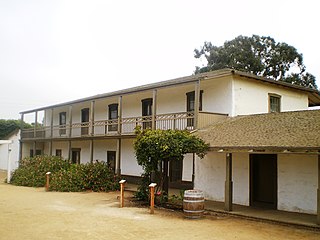
The Olivas Adobe in Ventura, California is an adobe structure built in 1837 by Raymundo Olivas on the north bank of the Santa Clara River about a mile from the estuary where it flows into the Santa Barbara Channel.
José María de Echeandía (?–1871) was the Mexican governor of Alta California from 1825 to 1831 and again from 1832 to 1833. He was the only governor of California that lived in San Diego.
General José María Flores was a Captain in the Mexican Army and was a member of la otra banda. He was appointed Governor and Comandante Generalpro tem of Alta California from November 1846 to January 1847, and defended California against the Americans during the Mexican–American War.

Captain José Antonio Ezequiel Carrillo (1796–1862) was a Californio politician, ranchero, and signer of the California Constitution in 1849. He served three terms as Alcalde of Los Angeles (mayor).
Salomón María Simeon Pico was a Californio, a cousin of former governor Pío Pico, who led a bandit band in the early years following the Mexican–American War in the counties of the central coast of California. Pico was considered by some Californios to be a patriot who opposed the American conquest of Alta California and its subsequent incorporation into the United States. He was hated for his banditry by the newly arrived Americans but protected by some Californios as a defender of his people.
The Rincon Parkway is a portion of California State Route 1 along the north coast of Ventura County, California. This narrow coastal area north of the city of Ventura and south of the Santa Barbara County line is commonly referred to as The Rincon. The automobile route along this portion of coastline opened up in 1913 as the Rincon Causeway or the Rincon Sea Level Road as the first driveable coastal route for motorists traveling between San Francisco and Los Angeles, California. The access road alongside the railroad bed, that cut through the area in 1886, provided the basis for building the Rincon Sea Level Road.
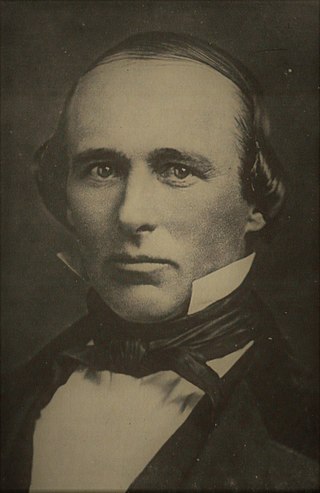
Rancho Ex-Mission San Buenaventura was a 48,823-acre (197.58 km2) Mexican land grant in present-day Ventura County, California given in 1846 by Governor Pío Pico to José de Arnaz. The grant derives its name from the secularized Mission San Buenaventura, and was called ex-Mission because of a division made of the lands held in the name of the Mission — the church retaining the grounds immediately around, and all of the lands outside of this are called ex-Mission lands. The grant extended east from present day Ventura, excluding the Rancho San Miguel (Olivas) lands, inland up the Santa Clara River to Santa Paula, between the north bank of the River and Sulphur Mountain.
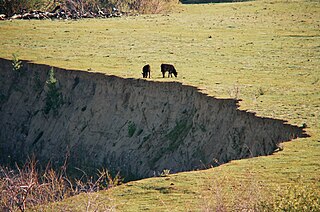
Rancho Cañada Larga o Verde was a 6,659-acre (26.95 km2) Mexican land grant in present-day Ventura County, California given in 1841 by Governor Juan B. Alvarado to Joaquina Alvarado. The grant extended along Sulphur Canyon Creek, east of the Ventura River, between Ventura and Ojai. To the west, across the Ventura River was Rancho Cañada de San Miguelito; to the north Rancho Ojai; and to the south and east Rancho Ex-Mission San Buenaventura.
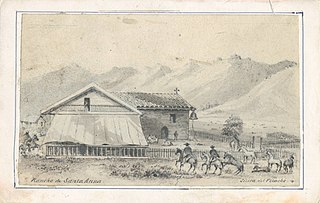
Rancho Santa Ana was a 21,522-acre (87.10 km2) Mexican land grant in present day Ventura County, California given in 1837 by Governor Juan Alvarado to Crisogono Ayala and Cosme Vanegas. Rancho Santa Ana was located inland in the Ventura River Valley on the west side of the Ventura River across from Rancho Ojai which was granted in the same year. Rancho Santa Ana encompassed present day Lake Casitas and Oak View.

Joseph John "Jose Juan" Chapman (1784–1849) was an American merchant sailor, then a crew member under the privateer Hippolyte Bouchard, then one of the earliest English-speaking settlers and builders of Mexican Alta California. Chapman was one of the first known American-born permanent residents of Alta California. The scanty and inconsistent historical record makes it difficult to be sure of many details of Chapman's life, but he was a valued member of several early southern California settlements, and interacted with a number of historical characters.

The Serra Cross, sometimes also known as the Cross on the Hill or the Grant Park Cross, is a Christian cross on a hill known as "La Loma de la Cruz" in Ventura, California. The site is in Serra Cross Park, a one-acre parcel within the larger Grant Park that overlooks downtown Ventura, the Santa Barbara Channel, and Anacapa and Santa Cruz Islands.
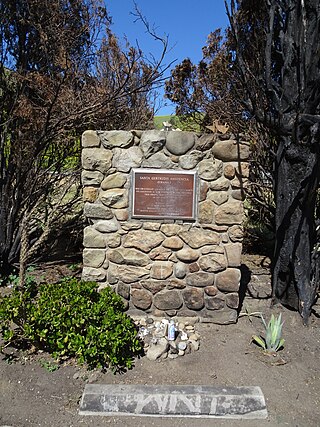
The Santa Gertrudis Asistencia, also known as the Santa Gertrudis Chapel, was an asistencia ("sub-mission") to the Mission San Buenaventura, part of the system of Spanish missions in Las Californias—Alta California. Built at an unknown date between 1792 and 1809, it was located approximately five miles from the main mission, inland and upstream along the Ventura River. The site was buried in 1968 by the construction of California State Route 33. Prior to the freeway's construction, archaeologists excavated and studied the site. A number of foundation stones were moved and used to create the Santa Gertrudis Asistencia Monument which was designated in 1970 as Ventura County Historic Landmark No. 11.

The Carrillo family is a prominent Californio family of Southern California. Members of the family held extensive rancho grants and numerous important political positions, including Governor of Alta California, Mayor of Los Angeles, Mayor of Santa Barbara, Mayor of Santa Monica, and a signer of the Californian Constitution.


















